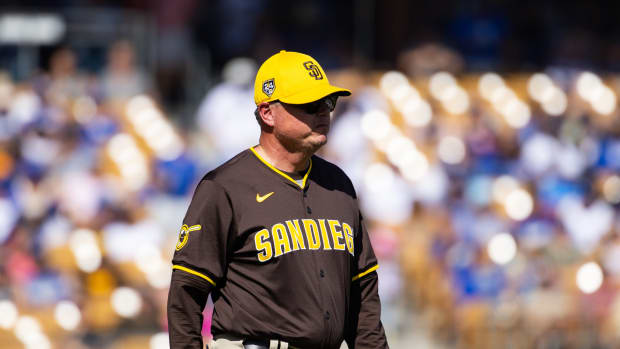Joe Morgan's Plea to Ban Steroid Users from the Hall of Fame is Simplistic and Reactionary
For years, the Baseball Hall of Fame has officially steered clear of the question as to how voters should handle the candidacies of players connected to performance-enhancing drugs. On Tuesday, however, Hall voters received a mass email from Joe Morgan, pleading with voters to reject "players who failed drug tests, admitted using steroids or were identified as users in Major League Baseball's investigation into steroid abuse, known as the Mitchell Report." Morgan, a Hall of Fame second baseman who has served on the institution's board of directors since 1994, used the Hall’s email address and signed the letter as "Hall of Fame Class of 1990" and "Vice Chairman," a capacity in which he has served the institution since 2000. In other words, this is unmistakably an official position.
Sent a day after the BBWAA's 2018 ballot was released, Morgan's letter is a reactionary attempt to halt the momentum of candidates Barry Bonds and Roger Clemens. Last year, the two candidates received more than 50% of the vote in their fifth year on the ballot, a significant threshold that has historically indicated future election. Bonds, the all-time home run leader and seven-time MVP, and Clemens, the seven-time Cy Young winner, have overwhelming statistical credentials for election, but have fallen short of 75% due to their connections to PEDs, which date to a time before MLB introduced testing and penalties for such use. Both have been acquitted of perjury and/or obstruction of justice charges pertaining to those connections, though only after tens of millions of dollars in taxpayer money was wasted on high-profile show trials.
Wrote Morgan:
"The more we Hall of Famers talk about this—and we talk about it a lot—we realize we can no longer sit silent. Many of us have come to think that silence will be considered complicity. Or that fans might think we are ok if the standards of election to the Hall of Fame are relaxed, at least relaxed enough for steroid users to enter and become members of the most sacred place in Baseball. We don't want fans ever to think that.
"We hope the day never comes when known steroid users are voted into the Hall of Fame. They cheated. Steroid users don't belong here.
…"It's gotten to the point where Hall of Famers are saying that if steroid users get in, they'll no longer come to Cooperstown for Induction Ceremonies or other events. Some feel they can't share the stage with players who did steroids."
Is Willie Mays, godfather to Barry Bonds, going to start boycotting Cooperstown? Can Morgan, Mike Schmidt and Johnny Bench, all of whom lobbied commissioner Bud Selig for the reinstatement of Pete Rose, who is banned from the game (and thus the Hall) for life due to gambling, credibly draw a line in the sand here? Are the dozens of other living Hall of Famers going to permanently forgo the annual opportunity to mingle with their peers in a setting they consider “sacred”?
Morgan’s letter may be sincere, but his phrasing is disingenuous. Notably, he uses term "steroids" and not "performance-enhancing drugs" in his letter. To these eyes, and to those of many other observers, it's an attempt to sidestep fact that amphetamine usage was rampant within the game for more than four decades, long after the drugs were made illegal. First detailed by pitcher Jim Brosnan in The Long Season, then later amplified by Jim Bouton—a teammate of Morgan's on the 1969–70 Astros—in Ball Four, amphetamines became widely available in clubhouses from the late 1950s. So-called "greenies" were used to fight fatigue and gain physical and mental edges. Hall of Famers from Mays, Mickey Mantle, and Hank Aaron to Schmidt, Bench, Willie Stargell, and Frank Thomas have been connected to amphetamines, some by their own accounts, and they were hardly alone. In 2003, Hall of Famer Tony Gwynn estimated that 50% of position players were using them routinely, a number on par with Ken Caminiti's 2002 estimate regarding steroid usage. Not until 2005, a year after testing for steroids was introduced, did MLB and the players' union ban amphetamines.
Chipper Jones, Jim Thome Join a Bulky 2018 Hall of Fame Ballot
''Guys feel like steroids are cheating and greenies aren't,” said Gwynn. But while he and his Hall peers may not have considered amphetamines to be performance enhancing, how else to describe drugs that keep players more alert, improve both reaction time and stamina, and ultimately keep them in the lineup more often, thus padding their statistics? They were illegal performance enhancers at that. Amphetamines were added to the Controlled Substance Act in 1970, and classified as a Schedule II drug a year later, which means that they were recognized both has having accepted medical uses but also a high potential for abuse which "may lead to severe psychological or physical dependence." Cocaine and most opiates (codeine, morphine, oxycodone) are also Schedule II substances.
By comparison, anabolic steroids were added to the CSA in 1990 as Schedule III substances, a label reserved for drugs with currently accepted medical uses but also the potential for "moderate or low physical dependence or high psychological dependence"—in other words, those recognized as less dangerous than Schedule II. Such drugs didn't enter the game with Bonds or Mark McGwire, either. In 2005, former reliever Tom House, who pitched in the majors from 1971–78, told a reporter that PEDs were widespread in the game in the 1960s and ’70s. “We were doing steroids they wouldn’t give to horses,” he said, estimating that six or seven pitchers per team were experimenting with steroids or HGH. “We didn’t get beat, we got out-milligrammed. And when you found out what they were taking, you started taking them.”
While both amphetamines and steroids were illegal, their usage was nonetheless quite common within the game. MLB had no means—and/or no will—to deter or punish such usage until the mid-2000s, when Congress forced the league's hand. A testing-and-suspension regiment for steroid usage was introduced in 2004 and enhanced in 2005. Though not unbeatable given the frequency with which players are tested, it has become the most rigorous of any team sport.
Amphetamine usage was never viewed as disqualifying in a Hall of Fame context, and voters really didn’t have to grapple with steroid usage until McGwire and Jose Canseco became eligible for election on the 2007 BBWAA ballot (released in November 2006, 13 months before the Mitchell Report was published). Canseco, a pariah thanks to his 2005 tell-all Juiced, received just 1.1% of the vote, removing him from further consideration while McGwire got a tepid 23.5%.
Some voters invoked the so-called "character clause" in the BBWAA's voting rules, which states that "Voting shall be based upon the player's record, playing ability, integrity, sportsmanship, character and contribution to the team(s) on which the player played." When I researched the history of the clause for my 2017 book The Cooperstown Casebook, what became clear was that prior to McGwire’s appearance on the ballot, it had rarely been mentioned by voters. When it was, it was in the context of justifying a vote in favor of a candidate, whether or not his election was a foregone conclusion. As invoked by voters in 2007 and thereafter, the clause conveniently ignores the fact that the Hall is a rogues' gallery not only of sign-stealers and spitballers but also players, managers and executives with worse sins of character. There are racists and Ku Klux Klan members, Prohibition-era alcoholics, cocaine users, amphetamine users, spousal abusers and sex addicts all adorned in Cooperstown. Judge Kenesaw Mountain Landis, the commissioner who wrote the clause, spent the entirety of his 24-year tenure upholding the color barrier.
And then there's Bud Selig, who was elected by the 2017 Today's Game Era Committee. As the owner of the small-market Brewers, he was among those who colluded to hold down player salaries during the mid-1980s, which eventually resulted in a $280 million damages payout to players. As acting commissioner, Selig presided over the owners' ham-fisted attempt to eliminate salary arbitration, restrict free agency, and institute revenue sharing tied to a salary cap. That disagreement resulted in the 1994 strike that scrubbed the World Series and required federal mediation to settle. Amid that prolonged labor war, he and the other owners turned a blind eye to the influx of PEDs until Congress got involved.
Yet the 16-member committee, which included eight Hall of Fame players, did not view Selig's role in those messes—which hardly demonstrated great character or integrity—as disqualifying. Instead they elected him with near-unanimity. The BBWAA voters noticed. As past BBWAA president Susan Slusser said via Twitter, "Senseless to keep steroid guys out when the enablers are in the Hall of Fame. I will now hold my nose and vote for players I believe cheated.” Voter Kevin Cooney of the Bucks County (Pennsylvania) Courier Times told The New York Times, “To me, it would be hypocritical to put the commissioner of the steroid era and a manager who had connections with the steroid era in and leave out the greatest pitcher and the greatest hitter of that time.” Cooney didn't detail which managers he meant, but 2015 honorees Bobby Cox, Tony La Russa and Joe Torre all benefited from players who were either suspended or otherwise implicated as PED users.
The Hall of Fame Is Incomplete Without Marvin Miller
Howard Bryant, whose 2005 book Juicing the Game chronicled the growth of baseball's steroid problem as well as the institutional failure that prolonged it, said on Tuesday via Twitter, "[I]nstitutional acceptance of blatant cheating was unprecedented from 1995–2007. People may have experimented, and I don't equate greenies with muscle-builders, but steroid era was top-down conspiracy, MLB condoned through inaction.”
Along with the gradual evolution of the electorate—with inactive voters removed from the rolls after 10 years of inactivity and younger ones who did not cover the height of the steroid era replacing them—reversals like those of Slusser and Cooney helped push Bonds and Clemens to 53.8% and 54.1%. With five years of eligibility remaining, both have time to build towards the requisite 75%, particularly as the electorate turns over.
From an official standpoint, the Hall has appeared to want things both ways, recognizing the accomplishments of steroid-linked players while tacitly hoping that they would not be honored with induction. “If Bonds is breaking home run records, we have the responsibility to record it,” said then-Hall president Dale Petroskey in 2007, as the slugger closed in on Aaron’s mark. “In the Museum, you’ll find artifacts from players who tested positive for performance-enhancing substances or played under that cloud of suspicion. It’s up to you to decide how you feel about those players and their feats,” said Jeff Idelson, Petroskey’s successor, in 2012.
Referring to the character clause, Idelson told SI's Joe Posnanski in 2011, "The character clause exists as it relates to the game on the field. The character clause isn’t there to evaluate and judge players socially … The voters should have the freedom to measure that however they see fit."
In the same interview, Idelson added, "When you look at the Hall of Fame elections, you see that those who are elected are representative of that era … I think we are happy with the way the voting has gone, we’re happy with the diligence of the voters who have participated, and the chips will fall as they fall.”
That interview took place when the writers were keeping McGwire and Rafael Palmeiro at bay and two years before Bonds, Clemens and Sammy Sosa became eligible. McGwire never received more than 23.6% of the vote and aged off the ballot in 2016 after the Hall took the step of truncating candidacies from 15 years to 10. Palmeiro, the fourth player to reach the dual milestones of 3,000 hits and 500 homers but also the first star to test positive for steroids, fell off the ballot after the 2014 election, when his support sank below 5%. Sosa has languished, receiving less than 10% in each of the past four elections.
The Aftermath: The Astros Lead Our Offseason Power Rankings
But while those players haven't made any progress, two who admitted to using androstenedione when it was still legal have been elected. “Andro,” a steroid precursor (it metabolizes into testosterone within the body) was made famous by McGwire during his 1998 home run chase but not banned by baseball or added to the Controlled Substances act until 2003. Mike Piazza, elected in 2016, told the New York Times in 2002 that he had briefly used andro, while Jeff Bagwell, elected in 2017, told the Houston Chronicle in 1998 that he had used it as well. Both players’ elections were delayed in part because some writers voiced "suspicions" about further usage that took place in the pre-testing era.
Years before those two were elected, longtime Washington Post writer Thomas Boswell, who reported as early as 1988 that Canseco was using steroids, told filmmaker Ken Burns in 2010, "There was another player now in the Hall of Fame who literally stood with me and mixed something and I said ‘What's that?’ and he said ‘it's a Jose Canseco milkshake.’ And that year that Hall of Famer hit more home runs than ever hit any other year.”
Boswell's player has never been definitively identified, but the story underscores just how belated Morgan's letter is, to say nothing of its other problems, not the least of which is self interest. With election to the Hall of Fame comes a small windfall that can amount to millions of dollars via higher fees for autographs and other memorabilia, a phenomenon chronicled in Zev Chafets' 2009 book, Cooperstown Confidential. So when Morgan and his peers fret about the honor being diluted, there's a financial incentive at stake. Since 2001, when the institution began an endless cycle of tinkering with the Veterans Committee, panels featuring living Hall of Famers haven't elected a single living ex-player and have elected just three deceased ones, only one of whom (Ron Santo) played in the post-1960 expansion era. Particularly when held against the much higher frequency with which the older VC elected players, one can't dismiss the motives of players unwilling to extend the honor.
The usage of PEDs in baseball is a dark chapter of the game’s history, and the one thing I’ve learned in analyzing PED-connected players for the Hall of Fame (both for SI.com and in Casebook, which tackles the game’s sordid PED history in even greater length than here) is that no matter what position you hold along a spectrum from zero tolerance to total agnosticism, somebody will vehemently disagree with you. Still, I've found it useful to distinguish between what came before testing and suspensions were introduced in 2004 (though the initial effort was so weak that the first suspensions didn't come until a year later) and what came afterwards.
The game's steroid problem was the result of a complete institutional failure that implicated the commissioner, the owners, the players' union and even reporters (don't forget, the one who broke the news about androstenedione in McGwire's locker was initially ostracized within the industry). If baseball couldn't punish the likes of McGwire, Bonds and Clemens during the "Wild West Era," then voters shouldn't be applying a retroactive morality. Which isn't to say that they need to rubber stamp every alleged user. They should view them within the context of their times.
Morgan's letter may well gain traction with some voters. It certainly has clarified the institution's stance, but it should be seen for what it is: a reactionary attempt simplify an issue that is tremendously complex, one that implicates the very Hall of Famers for whom Morgan purports to speak. If the Hall truly wants to enforce standards, it is better off keeping its thumb off the scale and letting the chips fall where they may.



































